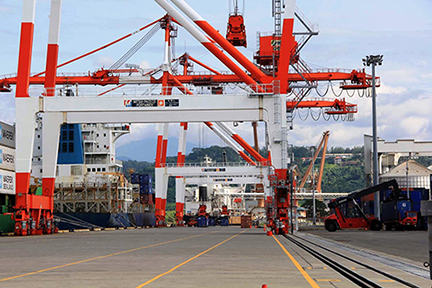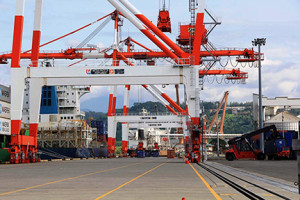

The Subic Bay Metropolitan Authority (SBMA) plans to expand the capacity of Subic port to 1.2 million twenty-foot-equivalent units (TEU) in three years’ time with a new box terminal, as it anticipates continued volume growth at the Northern and Central Luzon hub.
SBMA senior deputy administrator for operations Marco Estabillo told PortCalls they are in talks with the National Economic and Development Authority over the proposed construction of the New Container Terminal (NCT) 3 that will have two berths.
Whether the project is for bidding, under a public-private partnership, or funded by the government has yet to be determined.
With NCT 1 and NCT 2 having a combined capacity of 600,000 TEUs, Subic port can easily handle the approximately 450,000 TEUs that originate from or are destined for Central and Northern Luzon.
In a related development, SBMA chairman Roberto Garcia said the port is likely to hit the target volume of 70,000 TEUs for 2014. This after container traffic handled at Subic port reached an all-time high in November of 14,175 TEUs, 434.1% more than the 2,654 TEUs posted in the same month last year.
When the November volume is added to the 51,918 TEUs recorded from January to October 2014, the total throughput is 66,093TEUs. Subic port needs only 3,907 TEUs more in December to reach its target.
SBMA’s Estabillo noted that the port now averages 5,000 TEUs a month compared with the 2,000 TEUs in monthly average last year.
A source at Subic port operator Subic Bay International Terminal Corp (SBITC) told PortCalls the port already received 5,000 TEUs just in the first three days of December. The terminal, the source added, will likely handle more than 73,000 TEUs for the entire 2014.
Maersk call in Jan
The port also expects Danish carrier Maersk Line to connect Subic to Singapore by January 2015. The world’s biggest container liner will join five other shipping lines now calling Subic direct — APL, Wan Hai Lines, SITC and NYK Line.
Sources told PortCalls NYK’s ad hoc calls have also now been turned to regular calls after the carrier received commitment from tire manufacturer Yokohama to carry all its shipments out of Clark.
NYK Line made its first direct route to Port of Subic from Kaohsiung late last month. NYK’s MV Jakarta Towers, a 688-gross tonnage Liberian-flagged cargo vessel, made its first port call at Subic on Nov 23 and docked at the New Container Terminal 2 after sailing a day-and-a-half from Kaohsiung, Taiwan.
The cargo vessel unloaded about 110 container vans destined to consignees in Southern Luzon, including Toyota Motor (Phils.) Corp. in Santa Rosa, Laguna; and Canon Business Machines (Phils.) Corp. in Tanauan, Batangas. Also unloaded were cargoes for consignees in Central and Northern Luzon. These included Sumi Phils. Wiring System Corp. at the Hermosa Ecozone Industrial Park in Bataan; International Wiring System (Phils.) at Luisita Industrial Park and Special Ecozone inTarlac; and Yokohama Tires at Clark Freeport Zone in Pampanga.
One-stop shop for clearances
Furthermore, SBMA is coordinating with SBITC about constructing a temporary one-stop shop (OSS) in the terminal to house offices of the Bureau of Customs, SBMA and other government agencies needed for clearing shipments.
The temporary building, expected to be finished by mid-December, will operate while a permanent OSS building is being constructed. Port users lobbied for an OSS as the agencies needed to clear cargo at the freeport zone are located in different areas.
To accommodate the expected growth in volume from the land side, SBMA is also proposing the widening of the existing Tipo road, and the approval of the P3.9-billion bypass road project running from the Subic Clark Expressway to the Subic International Airport and the seaport terminal.
SBMA Chairman Garcia also had consultations last week with directors of the Chamber of Customs Brokers, Inc. (CCBI) regarding accreditation of port users in Subic. Garcia was a speaker at the CCBI annual general assembly last month where he detailed the advantages of using Subic as an alternative port to congested Manila– Roumina Pablo




